Shuohuan Wang
Advantageous Parameter Expansion Training Makes Better Large Language Models
May 30, 2025
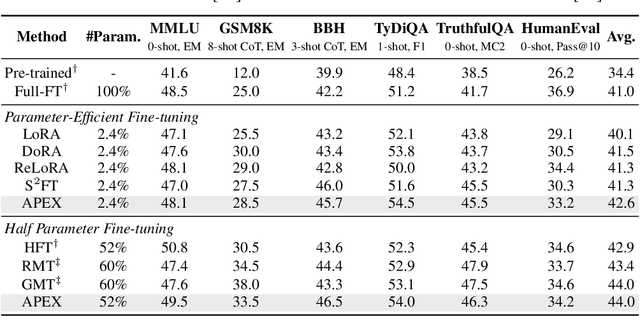
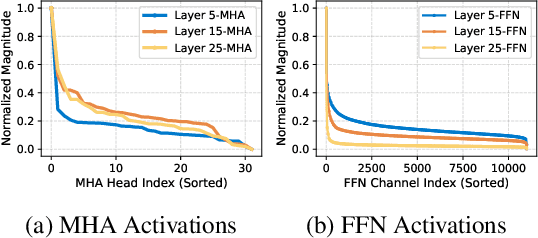
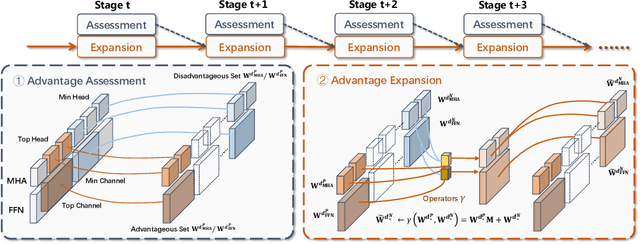
Abstract:Although scaling up the number of trainable parameters in both pre-training and fine-tuning can effectively improve the performance of large language models, it also leads to increased computational overhead. When delving into the parameter difference, we find that a subset of parameters, termed advantageous parameters, plays a crucial role in determining model performance. Further analysis reveals that stronger models tend to possess more such parameters. In this paper, we propose Advantageous Parameter EXpansion Training (APEX), a method that progressively expands advantageous parameters into the space of disadvantageous ones, thereby increasing their proportion and enhancing training effectiveness. Further theoretical analysis from the perspective of matrix effective rank explains the performance gains of APEX. Extensive experiments on both instruction tuning and continued pre-training demonstrate that, in instruction tuning, APEX outperforms full-parameter tuning while using only 52% of the trainable parameters. In continued pre-training, APEX achieves the same perplexity level as conventional training with just 33% of the training data, and yields significant improvements on downstream tasks.
Inner Thinking Transformer: Leveraging Dynamic Depth Scaling to Foster Adaptive Internal Thinking
Feb 19, 2025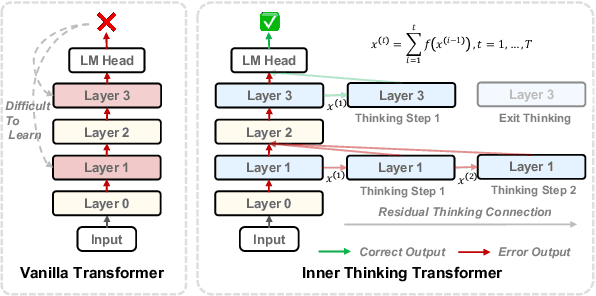
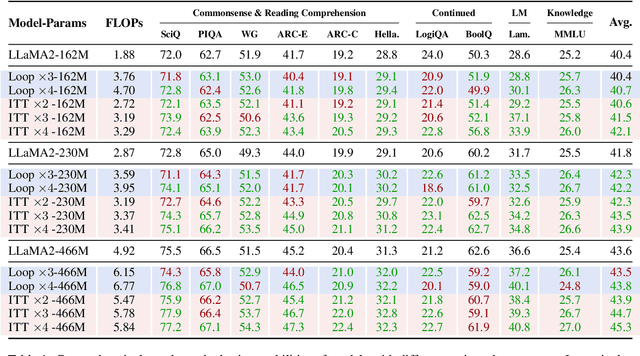
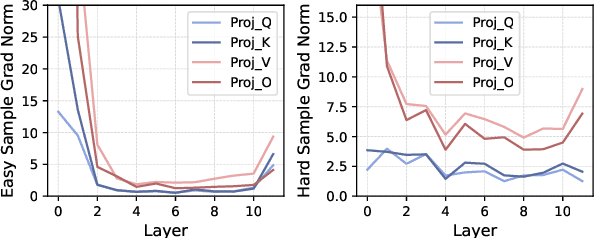
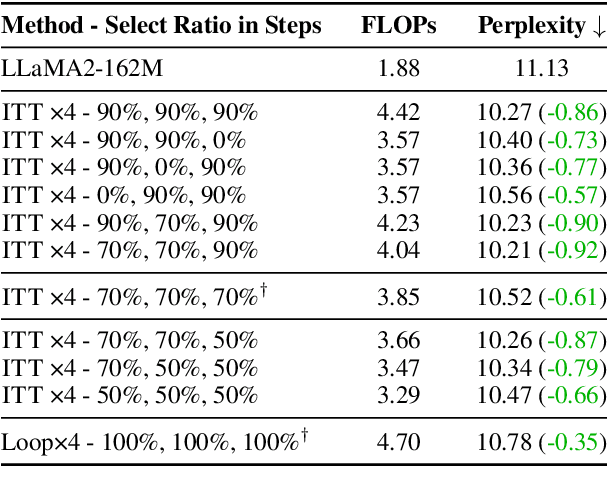
Abstract:Large language models (LLMs) face inherent performance bottlenecks under parameter constraints, particularly in processing critical tokens that demand complex reasoning. Empirical analysis reveals challenging tokens induce abrupt gradient spikes across layers, exposing architectural stress points in standard Transformers. Building on this insight, we propose Inner Thinking Transformer (ITT), which reimagines layer computations as implicit thinking steps. ITT dynamically allocates computation through Adaptive Token Routing, iteratively refines representations via Residual Thinking Connections, and distinguishes reasoning phases using Thinking Step Encoding. ITT enables deeper processing of critical tokens without parameter expansion. Evaluations across 162M-466M parameter models show ITT achieves 96.5\% performance of a 466M Transformer using only 162M parameters, reduces training data by 43.2\%, and outperforms Transformer/Loop variants in 11 benchmarks. By enabling elastic computation allocation during inference, ITT balances performance and efficiency through architecture-aware optimization of implicit thinking pathways.
BeamLoRA: Beam-Constraint Low-Rank Adaptation
Feb 19, 2025Abstract:Due to the demand for efficient fine-tuning of large language models, Low-Rank Adaptation (LoRA) has been widely adopted as one of the most effective parameter-efficient fine-tuning methods. Nevertheless, while LoRA improves efficiency, there remains room for improvement in accuracy. Herein, we adopt a novel perspective to assess the characteristics of LoRA ranks. The results reveal that different ranks within the LoRA modules not only exhibit varying levels of importance but also evolve dynamically throughout the fine-tuning process, which may limit the performance of LoRA. Based on these findings, we propose BeamLoRA, which conceptualizes each LoRA module as a beam where each rank naturally corresponds to a potential sub-solution, and the fine-tuning process becomes a search for the optimal sub-solution combination. BeamLoRA dynamically eliminates underperforming sub-solutions while expanding the parameter space for promising ones, enhancing performance with a fixed rank. Extensive experiments across three base models and 12 datasets spanning math reasoning, code generation, and commonsense reasoning demonstrate that BeamLoRA consistently enhances the performance of LoRA, surpassing the other baseline methods.
Curiosity-Driven Reinforcement Learning from Human Feedback
Jan 20, 2025



Abstract:Reinforcement learning from human feedback (RLHF) has proven effective in aligning large language models (LLMs) with human preferences, but often at the cost of reduced output diversity. This trade-off between diversity and alignment quality remains a significant challenge. Drawing inspiration from curiosity-driven exploration in reinforcement learning, we introduce curiosity-driven RLHF (CD-RLHF), a framework that incorporates intrinsic rewards for novel states, alongside traditional sparse extrinsic rewards, to optimize both output diversity and alignment quality. We demonstrate the effectiveness of CD-RLHF through extensive experiments on a range of tasks, including text summarization and instruction following. Our approach achieves significant gains in diversity on multiple diversity-oriented metrics while maintaining alignment with human preferences comparable to standard RLHF. We make our code publicly available at https://github.com/ernie-research/CD-RLHF.
Mixture of Hidden-Dimensions Transformer
Dec 10, 2024



Abstract:Transformer models encounter challenges in scaling hidden dimensions efficiently, as uniformly increasing them inflates computational and memory costs while failing to emphasize the most relevant features for each token. For further understanding, we study hidden dimension sparsity and observe that trained Transformers utilize only a small fraction of token dimensions, revealing an "activation flow" pattern. Notably, there are shared sub-dimensions with sustained activation across multiple consecutive tokens and specialized sub-dimensions uniquely activated for each token. To better model token-relevant sub-dimensions, we propose MoHD (Mixture of Hidden Dimensions), a sparse conditional activation architecture. Particularly, MoHD employs shared sub-dimensions for common token features and a routing mechanism to dynamically activate specialized sub-dimensions. To mitigate potential information loss from sparsity, we design activation scaling and group fusion mechanisms to preserve activation flow. In this way, MoHD expands hidden dimensions with negligible increases in computation or parameters, efficient training and inference while maintaining performance. Evaluations across 10 NLP tasks show that MoHD surpasses Vanilla Transformers in parameter efficiency and task performance. It achieves 1.7% higher performance with 50% fewer activation parameters and 3.7% higher performance with a 3x parameter expansion at constant activation cost. MOHD offers a new perspective for scaling the model, showcasing the potential of hidden dimension sparsity to boost efficiency
MA-RLHF: Reinforcement Learning from Human Feedback with Macro Actions
Oct 03, 2024



Abstract:Reinforcement learning from human feedback (RLHF) has demonstrated effectiveness in aligning large language models (LLMs) with human preferences. However, token-level RLHF suffers from the credit assignment problem over long sequences, where delayed rewards make it challenging for the model to discern which actions contributed to successful outcomes. This hinders learning efficiency and slows convergence. In this paper, we propose MA-RLHF, a simple yet effective RLHF framework that incorporates macro actions -- sequences of tokens or higher-level language constructs -- into the learning process. By operating at this higher level of abstraction, our approach reduces the temporal distance between actions and rewards, facilitating faster and more accurate credit assignment. This results in more stable policy gradient estimates and enhances learning efficiency within each episode, all without increasing computational complexity during training or inference. We validate our approach through extensive experiments across various model sizes and tasks, including text summarization, dialogue generation, question answering, and program synthesis. Our method achieves substantial performance improvements over standard RLHF, with performance gains of up to 30% in text summarization and code generation, 18% in dialogue, and 8% in question answering tasks. Notably, our approach reaches parity with vanilla RLHF 1.7x to 2x faster in terms of training time and continues to outperform it with further training. We will make our code and data publicly available at https://github.com/ernie-research/MA-RLHF .
Upcycling Instruction Tuning from Dense to Mixture-of-Experts via Parameter Merging
Oct 02, 2024



Abstract:Mixture-of-Experts (MoE) shines brightly in large language models (LLMs) and demonstrates outstanding performance in plentiful natural language processing tasks. However, existing methods transforming LLMs from dense to MoE face significant data requirements and typically rely on large-scale post-training. In this paper, we propose Upcycling Instruction Tuning (UpIT), a data-efficient approach for tuning a dense pre-trained model into a MoE instruction model. Specifically, we first point out that intermediate checkpoints during instruction tuning of the dense model are naturally suitable for specialized experts, and then propose an expert expansion stage to flexibly achieve models with flexible numbers of experts, where genetic algorithm and parameter merging are introduced to ensure sufficient diversity of new extended experts. To ensure that each specialized expert in the MoE model works as expected, we select a small amount of seed data that each expert excels to pre-optimize the router. Extensive experiments with various data scales and upcycling settings demonstrate the outstanding performance and data efficiency of UpIT, as well as stable improvement in expert or data scaling. Further analysis reveals the importance of ensuring expert diversity in upcycling.
NACL: A General and Effective KV Cache Eviction Framework for LLMs at Inference Time
Aug 07, 2024Abstract:Large Language Models (LLMs) have ignited an innovative surge of AI applications, marking a new era of exciting possibilities equipped with extended context windows. However, hosting these models is cost-prohibitive mainly due to the extensive memory consumption of KV Cache involving long-context modeling. Despite several works proposing to evict unnecessary tokens from the KV Cache, most of them rely on the biased local statistics of accumulated attention scores and report performance using unconvincing metric like perplexity on inadequate short-text evaluation. In this paper, we propose NACL, a general framework for long-context KV cache eviction that achieves more optimal and efficient eviction in a single operation during the encoding phase. Due to NACL's efficiency, we combine more accurate attention score statistics in PROXY TOKENS EVICTION with the diversified random eviction strategy of RANDOM EVICTION, aiming to alleviate the issue of attention bias and enhance the robustness in maintaining pivotal tokens for long-context modeling tasks. Notably, our method significantly improves the performance on short- and long-text tasks by 80% and 76% respectively, reducing KV Cache by up to 50% with over 95% performance maintenance. The code is available at https: //github.com/PaddlePaddle/Research/ tree/master/NLP/ACL2024-NACL.
DHA: Learning Decoupled-Head Attention from Transformer Checkpoints via Adaptive Heads Fusion
Jun 03, 2024



Abstract:Large language models (LLMs) with billions of parameters demonstrate impressive performance. However, the widely used Multi-Head Attention (MHA) in LLMs incurs substantial computational and memory costs during inference. While some efforts have optimized attention mechanisms by pruning heads or sharing parameters among heads, these methods often lead to performance degradation or necessitate substantial continued pre-training costs to restore performance. Based on the analysis of attention redundancy, we design a Decoupled-Head Attention (DHA) mechanism. DHA adaptively configures group sharing for key heads and value heads across various layers, achieving a better balance between performance and efficiency. Inspired by the observation of clustering similar heads, we propose to progressively transform the MHA checkpoint into the DHA model through linear fusion of similar head parameters step by step, retaining the parametric knowledge of the MHA checkpoint. We construct DHA models by transforming various scales of MHA checkpoints given target head budgets. Our experiments show that DHA remarkably requires a mere 0.25\% of the original model's pre-training budgets to achieve 97.6\% of performance while saving 75\% of KV cache. Compared to Group-Query Attention (GQA), DHA achieves a 5$\times$ training acceleration, a maximum of 13.93\% performance improvement under 0.01\% pre-training budget, and 4\% relative improvement under 0.05\% pre-training budget.
HFT: Half Fine-Tuning for Large Language Models
Apr 29, 2024



Abstract:Large language models (LLMs) with one or more fine-tuning phases have become a necessary step to unlock various capabilities, enabling LLMs to follow natural language instructions or align with human preferences. However, it carries the risk of catastrophic forgetting during sequential training, the parametric knowledge or the ability learned in previous stages may be overwhelmed by incoming training data. In this paper, we find that by regularly resetting partial parameters, LLMs can restore some of the original knowledge. Inspired by this, we introduce Half Fine-Tuning (HFT) for LLMs, as a substitute for full fine-tuning (FFT), to mitigate the forgetting issues, where half of the parameters are selected to learn new tasks while the other half are frozen to remain previous knowledge. We provide a feasibility analysis from the perspective of optimization and interpret the parameter selection operation as a regularization term. Without changing the model architecture, HFT could be seamlessly integrated into existing fine-tuning frameworks. Extensive experiments and analysis on supervised fine-tuning, direct preference optimization, and continual learning consistently demonstrate the effectiveness, robustness, and efficiency of HFT. Compared with FFT, HFT not only significantly alleviates the forgetting problem, but also achieves the best performance in a series of downstream benchmarks, with an approximately 30% reduction in training time.
 Add to Chrome
Add to Chrome Add to Firefox
Add to Firefox Add to Edge
Add to Edge